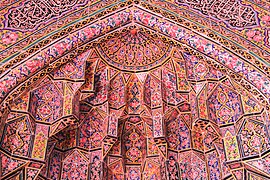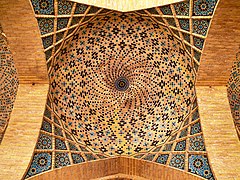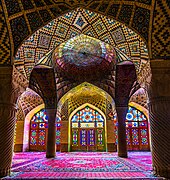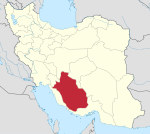Nasir-ol-Molk Mosque
| Nasir al-Mulk Mosque | |
|---|---|
 | |
| Religion | |
| Affiliation | Islam |
| Province | Fars Province |
| Status | Active |
| Location | |
| Location | |
| Municipality | Shiraz County |
| Geographic coordinates | 29°36′31″N 52°32′54″E / 29.60861°N 52.54833°E |
| Architecture | |
| Type | Mosque |
| Style | Iranian architecture |
| Completed | 1888 |
| Website | |
| http://nasiralmulk.ir/ | |
The Nasir al-Mulk Mosque (Template:Lang-fa Masjed-e Nasir ol-Molk), also known as the Pink Mosque (مسجد صورتی Masjed-e Surati), is a traditional mosque in Shiraz, Iran. It is located in Gawd-i Arabān quarter, near Shāh Chérāgh Mosque. It was built during Qajar dynasty rule of Iran.
The mosque includes extensive coloured glass in its facade, and displays other traditional elements such as the Panj Kāse ("five concaved") design. It is named in popular culture as the 'Pink Mosque',[1] due to the usage of a considerable number of pink-colored tiles for its interior design.[2]
History
The mosque was built during the Qajar dynasty, and is still in use under protection by the Endowment Foundation of Nasir al Molk. Construction began in 1876 by the order of the late Hassan Ali Nasir al-Molk, one of the lords and aristocrats of Shiraz, the son of Mirza Ali Akbar Qavam-ol-Molk, the ruler of Fars and was completed in 1888. The designers were Mohammad Hasan-e-Memār, an Iranian architect who had also built the noted Eram Garden before the Nasir al-Molk Mosque, Mohammad Hosseini Shirazi, and Mohammad Rezā Kāshi-Sāz-e-Širāzi.[3]
Westernization of the mosque
With the rise of the Qajar dynasty, European culture was becoming more and more popular in Iran. Many elementary and secondary schools were built by Britain, The United States, and France all throughout Iran promoting European ideology and culture.[4] Naser al-Din Shah Qajar, who ruled Persia from 1848 to 1896, was heavily influenced by European culture. He built Dar ul-Funun College in Tehran, which was founded in 1852 to teach European languages and technical subjects including photography and lithography. With this wave of European and American missionaries, Iran started relying heavily on European products, one of which was colorful ceramics used in Iranian architecture. Although Persia was known for its production of glazed tiles with geometrical shapes and their use in mosques and shrines, mostly seen in the architecture of Isfahan , there was a steep decline in the production of tilework in Iran in 18th century. The Qajar period came with the revival of the production of tilework in parallel with the importation of floral and bright-colored designed tilework from factories in Britain, France, and Germany. Tilework imported from Europe was characterized with having depictions of landscape, European architecture, or beautiful women and were widely used in the interiors of residential houses and palaces in the Qajar period.[5] Nasir al Molk mosque was built at the peak of the westernization of Iran. We see many depictions of western architecture on tilework displayed on the interior walls of the mosque as well as oddly bright colorful designs defining the mosque uniquely from original Persian architecture seen in the 13th and 14th century. Although the iwan of the mosque is very similar in structure to the original iwans seen in many Persian mosques, such as Shah Mosque (Isfahan), in Nasir al Molk mosque the iwan is designed with bright-colored floral designs rather than turquoise colored geometrical shapes. Floral designs and western architectural depictions on walls of the mosque make up an important undeniable feature of the mosque showing the western influence on Islamic Iran in the 19th century.
Orsi: Persian Stained Glass
Although stained glass is mostly popular in churches nowadays, the earliest discovered was in Syria from the 7th century.[dubious – discuss] We do have evidence of techniques and recipes for obtaining stained glass by the Arabic chemist Jabir ibn Hayyan in his book Kitab al-Durra al-maknuna (The Book of the Hidden Pearl) published in the eighth century CE.[6] Orsi windows are windows made of a mixture of wood and colorful glass in the Safavid and the Qajar dynasties. Orsi differs from stained glass used in many churches and Ottoman mosques which serve as illuminated images rather than a source of light. Light is a major feature in many mosques considering it being a major symbol of God in Islam. This is mentioned in a chapter in Quran:
″Allah is the light of the heavens and the earth″[7]
Orsi in Nasir al Molk mosque creates a major definitive feature that makes up the colorful spiritual feeling of awe in the visitor when entering. The main purpose of Orsi is creating colorful light on the interior of the building. The mosque has seven wooden doors with colorful Orsi connecting the interior mosque to the courtyard. Orsi windows are characterized for using geometric shapes in their designs due to the prohibition of images and icons in islamic art.[8]
Gallery
-
Winter prayer hall
-
Winter prayer hall
-
Outside of the mosque
-
Outside of the mosque at night
-
Muqarnas of Nasir-ol-molk Mosque
-
Ceilings of the winter prayer hall
-
Decoration of the mosque
-
Mosaic dome interior
-
interior


See also
References
- ^ Mosque of Whirling Colours: A Mixture of Architecture and Art in Nasīr al-Mulk Mosque in Shiraz, Iran Archived 2016-05-11 at the Wayback Machine, Cem Nizamoglu, MuslimHeritage.com
- ^ CNN: Why your next vacation could be in Iran, Frederik Pleitgen – 14 July 2015
- ^ “A Mixture of Architecture and Art in Nasir Al-Mulk Mosque in Shiraz, Iran.” Nasir Al-Mulk Mosque, http://nasiralmulk.ir/.
- ^ Young, T. Cuyler. The Problem of Westernization in Modern Iran. Middle East Institute, 1948.
- ^ Gleave, R. Religion and Society in Qajar Iran. RoutledgeCurzon, 2009.
- ^ Al-Hassan, Ahmad Y. “AN EIGHTH CENTURY ARABIC TREATISE ON THE COLOURING OF GLASS: KITĀB AL-DURRA AL-MAKNŪNA (THE BOOK OF THE HIDDEN PEARL) OF JĀBIR IBN ḤAYYĀN (c. 721–c. 815).” Arabic Sciences and Philosophy, vol. 19, no. 1, 2009, pp. 121–156.
- ^ The Qur'an [24:35]
- ^ Faghihi, Parinaz, et al. “Architectural Glass in the 18th to 20th Centuries in Iran .” Proceedings of the 5th GLASSAC, 2017, pp. 43–45.
External links
- Nasir ol Molk Mosque on Art-Days.com
- Nasir ol Molk Mosque on Albert-Videt.eu (in French)
- BBC Persian: Nasir ol Molk (in Persian)











